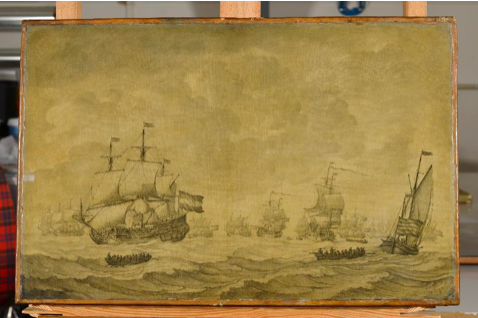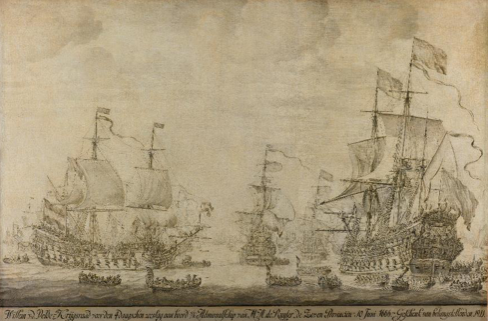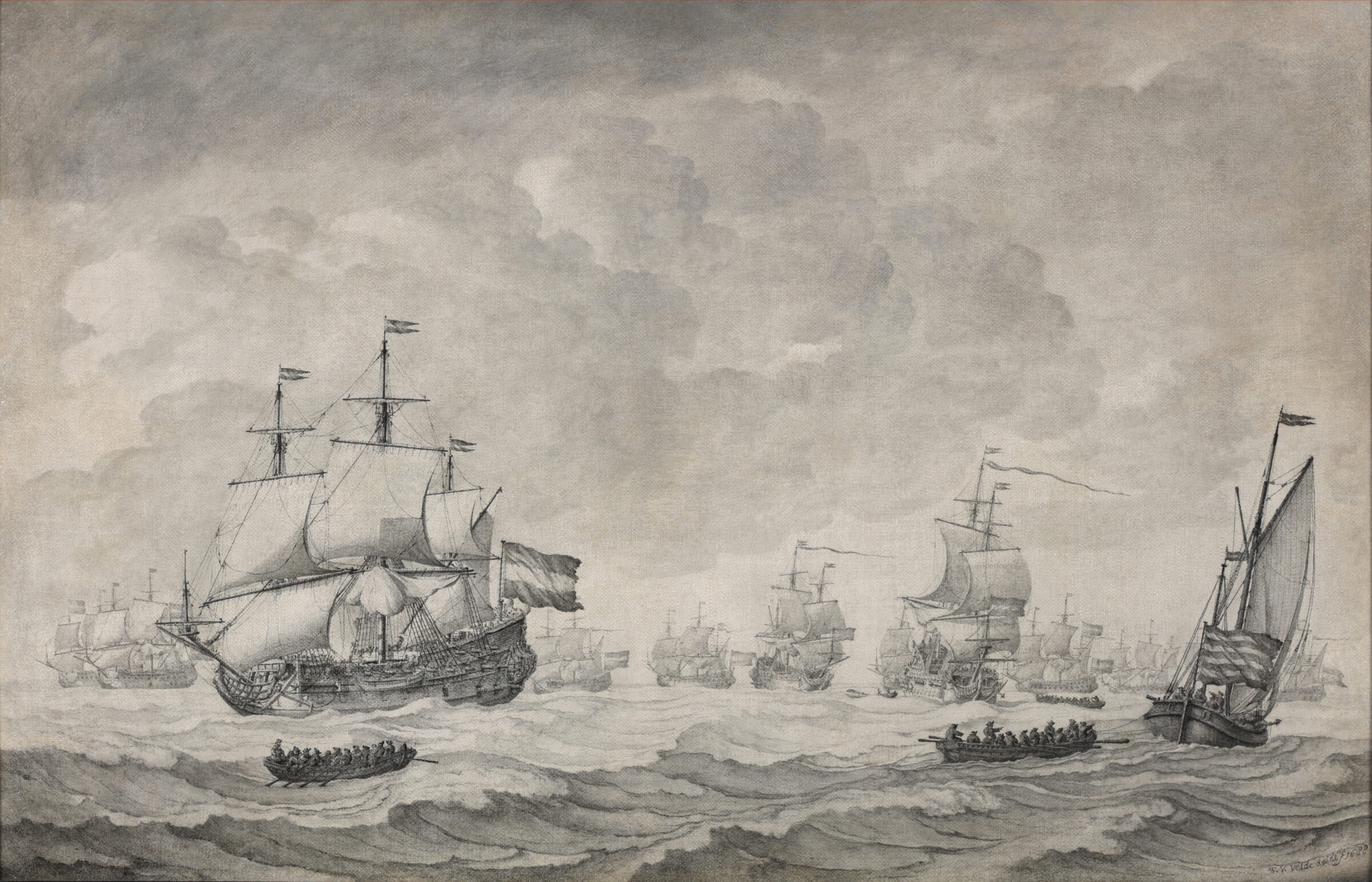A council of war on the Dutch fleet
Is leeg, of bestaat niet
Artist: unknown

Leiden 1611 – 1693 London
Pen painting and grisaille on canvas 36 x 53.3 cm.,
Fully signed and dated lower right ‘W.V.Velde doude F1688’.
Provenance
Collection E.E. London
His sale, Lepke Berlijn, 8 April 1913, lot no. 119
Collection G.J. de Groot Jamin 12 December 1922, lot no. 194
Bought at this auction by B. Houthakker, stock no. 650
Ca. 1930 collection Dr. A.E. Bye Philadelphia.
Ca. 1934 collection J.C.H. Heldring
His sale Sotheby’s Londen 27 March 1963, lot no. 25
Collection C.J.A. Castendijk
Delft Antiekbeurs 1981, Kunsthandel Castendijk
With Castendijk Rotterdam, June 1988 (according to Robinson)
Private collection, The Netherlands
Literature
H.P. Baard, Willem van de Velde, 1942, p. 33, ill. p. 30
Hannema, D., Catalogue raisonné of the pictures in the collection of J.C.H. Heldring, 1955, nr. 33, pl. 35
M.S. Robinson, A Catalogue of the Paintings of The Elder and the Younger Willem van de Velde, volume I, 1990, p.82, 83 nr. 372
Exhibited
– Amsterdam 1929, exhibition Handelaren Oude Kunst
– Arnhem Gemeentemuseum 1958, collection J.C.H. Heldring, Oosterbeek, cat. no. 35, ill. 41,42
– Utrecht, Centraal Museum 1960, collection J.C.H. Heldring, Oosterbeek, cat. no. 41, ill. 40
– Delft, Oude Kunst- en antiekbeurs, 1981
– Borg Verhildersum, Leens 2001, ’s Lands schip Verhildersum, Drie tentoonstellingen rond een tekening van Willem van de Velde, tent.cat. Leens 2001, p.67,68 .
A late work by Willem van de Velde the Elder
In the older art-historical literature, the works of Willem van de Velde the Elder are often referred to as ‘grisaille’, rather than the current term ‘pen painting’. This work would merit both descriptions actually: apart from the pen, the artist generously used the brush. This is a typical example of Van de Velde’s production in his later years, when he lived in England (since 1672/73). He still drew regularly in those years, though no longer during sea battles, but he put a lot of time into the acquisition of commissions. He left the elaboration of his drawing work into saleable finished products to his son, the painter Willem van de Velde the Younger (1633-1707). His own production was significantly smaller than in the Dutch period: smaller pen paintings, executed with more brush. He also occasionally applied himself to oil painting, more as a hobby, it seems, than as a marine painter of his son’s level. He signed his work from his later years in full, as on this painting with ‘W.V.Velde doude ‘(the Elder), sometimes even indicating his age, for instance ‘oudt 74 Jaren’ on a pen painting from 1685.
The picture
In a moderate breeze, coming from the right in the painting, a number of Dutch warships, a galliot and some rowboats sail on a lightly heaving sea. The sunlight is also coming from the right. The two-decked vessel on the left, seen on its port side, is the leading figure in this scene. It lies sharply to the wind, almost motionless. The topgallant sails (the highest square sails) are lowered, the main course is clewed up. The ship’s sloop is being lowered and is still hanging by slings above the water. From the masts fly small, forked Dutch flags, from the poop a large tricolour. Further away are a number of similar ships, under similar sail. On the far right in the foreground, a bezan rigged galliot sails out of the picture. At the stern it flies a large flag with nine stripes, apparently the triple red-white-and-blue Prince’s’ Flag, which was mainly in use with the Amsterdam Admiralty. Th galliot is towing a sloop full of people, including eight rowers. Several more similar sloops are visible in the foreground left and background.
What do we see here?
The scene has been variously interpreted in the past. H.P. Baard and other Dutch authors through that this depicts a famous maritime event from 1688 (the date on the painting): the departure of Stadholder William III’s fleet to England. The latter sailed there to claim the throne for himself and his wife Mary Stuart: the Glorious Revolution. However, there are too few clues for this explanation, apart from the warships and the year. The departure of William’s fleet, on 11 November 1688, was accompanied by huge crowds, numerous small vessels and a lot of flag display, as can be seen from many images in print or painting. None of that is shown here. Moreover, the crossing took place in November 1688, which left little time for Van de Velde to make a pen painting that same year, although the English calendar gave him some leeway: in that country, the Julian calendar was still in use, which was ten days behind the modern Gregorian calendar, and did not start the new year until 25 March (the day of the Annunciation). Besides, Van de Velde was living in England at the time of the Dutch invasion, and will have had little information about it. Michael Robinson rightly notes: ‘This would be an unlikely subject for the Elder as he had been patronised by James II, and is unlikely to have had commissions from people serving William’. However, Robinson’s alternative explanation is not very acceptable either. He suggests that the canvas was commissioned by the captain of the large ship shown on the left and that Van de Velde was on board the galliot on the right. But if this is really a ship’s portrait with some additions, then Van de Velde would have depicted the stern of the vessel he was asked to portray. That is the place par excellence where the distinguishing features, indicating the ship’s name, are displayed. Now we see nothing more than an average three-decker from the war fleet.
A council of war at sea
The key to the explanation of this image lies in the heavy traffic of rowing boats on the high sea. They all appear to be heading for a large ship, starboard bow view, with a long pennant flying from the main mast. That pennant indicates that this is the ship of one of the commanders of the fleet squadron pictured. There, they are apparently expected for the council of war, the consultation of the squadron captains. The sloop being lowered from the ship on the left is presumably intended to take the captain there, too. The sloop behind the galliot – no doubt modelled on the galliots Van de Velde often sailed on – apparently could not cope with the waves and wind and is given a lift to the flagship.

1. Willem van de Velde the Younger, A council of war in the Dutch fleet, before the Four Days’ Battle, 1666. Graphite and wash on paper. Amsterdam, Rijksmuseum, inv. RP-T-1961-95

2. Willem van de Velde the Elder,) Council of War aboard the Zeven Provinciën, the flagship of Michiel Adriaensz de Ruyter, 10 June 1666, preceding the Four Days’ Battle. 1666 – 1693. Pen painting, c. 1667. Amsterdam, Rijksmuseum, inv. SK-A-4289 (Robinson, Paintings, nr. 332, pp 70-71)
Van de Velde probably made this pen painting using older drawings and memories from his Dutch period, before 1672. At that time he and his son more than once drew a council of war in the fleet of the Dutch Republic, for example on the eve of the Four-Days’ Battle in 1666 (fig.1). A pen painting in a larger format than the work described here also has a council of war at sea as its subject, in 1666 (fig. 2).
There is another pen painting by Van de Velde, also dated 1688, same size, and with a comparable subject. It is executed in the same style, with a similar treatment of the waves and also with a lot of wash. Robinson gave that painting the title ‘The Dutch ship Gouda at sea with the fleet before the Four Days’ Battle'(1666). That canvas also shows several sloops amid a large number of warships at sea. Size, style and subject confirm the assumption that both canvases depict events from the same naval battle in 1666. The Gouda was the ship of Rear Admiral Isaac Sweers. He was killed in 1673, but his family may have ordered this canvas (and possibly also the one described in this essay) from Van de Velde. During the Four Days Battle between the British and the Dutch, Sweers played an important role, especially in the capture of the Royal Prince. Both Van de Veldes immortalised that act of war on several occasions.
Conclusion
This small pen painting is one of the last works by the renowned draughtsman Willem van de Velde the Elder. When he completed the canvas, he must have been 76 or 77 years old. It is remarkable that at that age he still managed to achieve a fine result with such ease and precision. That he used a smaller format and applied more brushwork is understandable considering his age: it saved time and effort. The subject of this pen painting/grisaille is the beginning of a council of war at sea, with sloops carrying the participating officers to the commander’s flagship. Van de Velde will have witnessed such events regularly during the time he sailed in a galliot with the war fleet of the Dutch Republic. The painting cannot with certainty be identified as depicting a specific event but it may have been inspired by the Four Days‘ Battle of 1666, an engagement battle Willem van de Velde the Elder himself had been a witness to.
Appendix:
The Willem van de Veldes
Two artists, father and son, both called Willem van de Velde, dominated the field of Dutch marine painting during a long period of the seventeenth century and well into the eighteenth century. Willem van de Velde the Elder (Leiden 1610- London 1693) and his son Willem van de Velde the Younger (Leiden 1633- London 1707) were famous for their drawings and oil paintings of ships, coastal scenes and navy activities at sea. The works by both artists portray the maritime world of their time in an almost inimitable way.
The Van de Veldes came from a family of inland bargemen in Leiden. One year after the son’s birth, in 1634, they moved to Amsterdam, in those days the most important port of Europe and a centre of the arts, including maritime print making and painting. Van de Velde the Elder, a talented self-taught draughtsman, created a niche for himself by making so-called pen paintings, time consuming works, mainly sold to a wealthy clientele. The training of his son consisted of drawing lessons at home and an apprenticeship (1650-1653) in the studio of Simon de Vlieger (1601-1653) in Weesp, near Amsterdam. Around the middle of the 1650s father and son worked together in their studio in Amsterdam, producing pen paintings and oil paintings. The drawings made at sea by the Elder, served as documentation for both artists.
In 1672, in the middle of the Third Anglo-Dutch War, both Van de Veldes settled in England, after an invitation by king Charles II. The king granted them a royal pension and assigned them the Queen’s House in Greenwich as a studio, in particular for making designs for tapestries. In England the careers of the Van de Veldes took slightly different directions. The Elder devoted more of his time to the marketing of their firm, whereas the son was in charge of the studio. After the Glorious Revolution of 1688, the Van de Veldes seem to have lost their privileged position as court painters. The new sovereign, William III of Orange, may have been a fellow countryman of theirs, but he did not have the deep interest in maritime affairs that Charles II and James II in particular had. The Van de Veldes moved to Westminster, where they opened a flourishing studio, with clients mainly from circles around the navy, trade and shipping. William van de Velde the Elder died there in 1693, his son continued working until his death in 1707. Both were buried in their new homeland, in St. James’s Church, Piccadilly.
Amsterdam, 2 February 2023
dr. Remmelt Daalder
maritime art & history
Amsterdam – The Netherlands
Share this artwork:
Year: 1611 - 1693
Location: Leiden / London
Dimensions: 36 x 53.3 cm
Provenance: Collection E.E. London
Techniques: Pen on canvas

